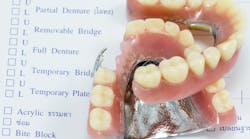“What’s in Your Mouth?”: Clarifying the relationship between dentist, patient, and lab
Napier explained that the lack of regulations in the industry has led to a lack of transparency in the channels of communication between dental laboratories, dentists, and the patients who receive restorations. This lack of transparency can lead to health problems for patients, as well as legal problems for dentists.
The NADL has made efforts to encourage stricter regulations, but the regulations have yet to be adopted by all 50 states. In fact, according to the NADL, only four U.S. states currently require certification or continuing education for dental laboratories and technicians, although a few other states do have disclosure requirements.
Despite this widespread lack of regulations, a 2009 American Dental Association (ADA) member survey revealed that about 65% of dentists believe that dental laboratories and technicians in their state are licensed. The results of the survey illustrate the need for dentist education and, consequently, consumer education about dental laboratories and the restorations they produce – hence, the new NADL campaign.
Some of the confusion about lab certification may stem from the fact that labs and lab techs were more likely to have been certified in the past. According to Napier, a consolidation of over 30% in the total number of dental labs has occurred since 2008. Between this consolidation and the retirement of many experienced lab techs and lab owners, the market for certified restorations is dwindling.
Furthermore, newer dentists, who have fewer hours of experience with restorative dentistry, are more likely to rely on the lab. While reliance on the lab isn’t necessarily negative, problems can arise for dentists who neglect to ask questions about the origin of restorations or about materials used in the restorations.
According to Napier, receiving grey market materials is one problem that can manifest when dentists put their blind trust in labs. Without regulations to make labs accountable, labs can substitute counterfeit restorative materials for brand name, government-regulated materials. Similarly, a dentist writing a prescription for a high noble crown could receive a base noble crown instead. Such a mishap could cause allergic reactions for some patients, as base noble crowns contain nickel, but it would not cause any repercussions for the lab.
Infection control and material safety, however, are the primary issues associated with the lack of transparency in the industry. Without regulations, unsanitary labs can operate freely. Take, for example, the basement lab in Springfield, Ohio, that was exposed by a news story last year. “The [images of that basement lab] convey why we’re seeking some type of standard,” said Napier.
Another example is the 2008 story about an Ohio woman who developed lead poisoning from a restoration that had been imported from China, which catalyzed a larger investigation of restorations imported into the United States.
FDA data reveals that 38% of restorations in the United States today are imported from foreign labs, which do not undergo the same surveillance as domestic labs. Since some domestic labs import and sell foreign products, which are cheaper, the NADL cautions dentists to ask their labs about the origin of the restorations and the origin of the materials used to make the restorations.
“Dentists today have to be diligent about where they purchase their products because dental lab certification is voluntary, which means that there are fewer options," said Napier. "Dentists shouldn’t take for granted that the lab they’re using is certified.”
For as long as labs remain unregulated – and perhaps even beyond, dentists need to take a few extra steps in order to establish clarity in the dentist-lab-patient relationship. The first step in protecting the health of patients is checking to see if the lab you're using is a Certified Dental Lab (CDL), if it employs at least one Certified Dental Technician (CDT), or if it is Dental Appliance Manufacturers Audit System (DAMAS) accredited.These certifications and DAMAS accreditation help to ensure safe and quality products.
You should also make sure that you're asking questions of the labs you use. Steven Pigliacelli, CDT, MDT, the Vice President and Director of Education at Marotta Dental Studio, Inc., recommends asking the lab whether they use certified materials and implant components, as well as whether they send any of their work offshore. Performing a physical inspection of the lab’s facilities is another critical initial step.
After inspecting the lab and asking the necessary questions about certification and materials, Pigliacelli recommends building a relationship with the lab much like one might begin developing a romantic relationship.
"It's important that you court each other before you go forward, and it pays off," he said. “[Courting]” the lab means trying it out, one restoration at a time. "Don't give all your work at one time," he said. "Try one crown, another crown, build a relationship."
Dentists aren't the only people who can take measures to promote transparency, however. Professionals at some labs, such as Marotta, are also looking to improve communication between dentists and laboratories. At Marotta, Pigliacelli acts as a technical liaison between dentists and labs, teaching courses with a curriculum that he designs to help clarify the relationship between the dentist and the lab.
Marotta's program helps them to maintain patient-focused partnerships with dentists. "It's a mutual give-and-take," said Pigliacelli. "There's no apprehension to call the doctor to request a new impression. You can put away pride. It's very good to have open communication to explain what needs to be done so we can work best for the patient. The patient comes first. A joke I always make is, 'I like it when they say, "Dr. So-and-So is on the phone."' It's just a relationship, and we work as a team."
In sum, both dentists and labs can work to achieve a more transparent relationship, a goal that will allow them to put patients at the center of that relationship.
For more information about improving clarity in the dentist-lab-patient relationship, check out the website for the NADL’s "What's in Your Mouth?" campaign at dentallabs.org, a portal through which both consumers and dental professionals can learn more about this issue.
Editor’s Note:Dentists, we’d like to hear from you! Have you worked with any labs that have particularly clear channels of communication or that do an excellent job of building relationships with dentists? Tell us what they do and why it works for you. We’d also like to hear about any issues that you might have had in your communications with labs. Tell us what happened and what needed to be improved. To share your experiences, email [email protected].






